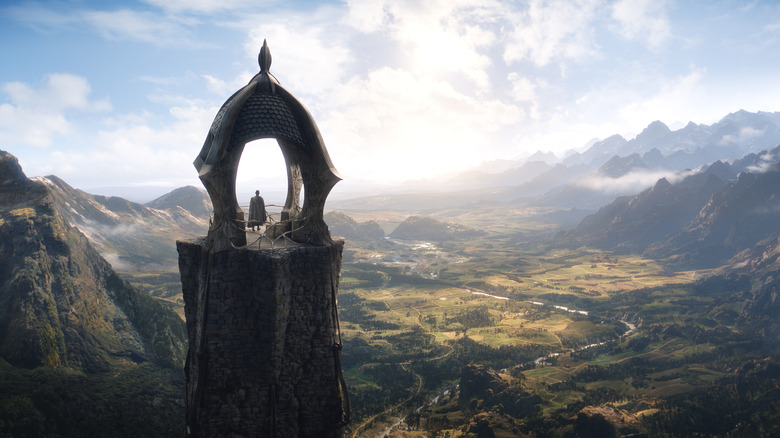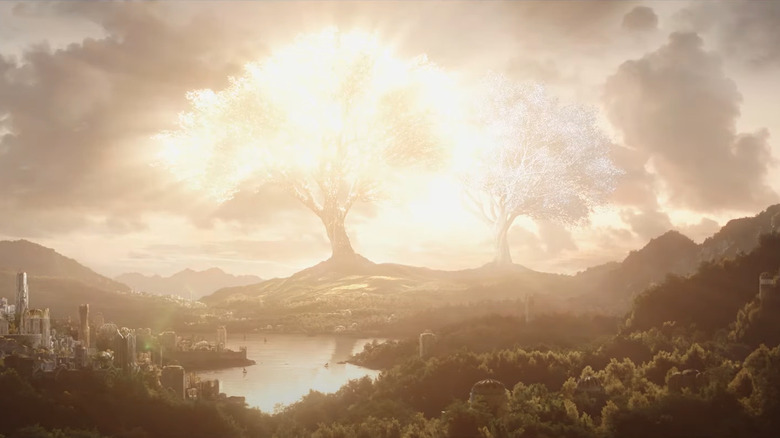The Rings Of Power: How J.A. Bayona Used The Landscape To Tell Epic Stories
J.R.R. Tolkien's world of Middle-earth is simultaneously massive and minute, sprawling and specific, epic and exhaustive. The Professor engaged in sweeping narratives that span centuries in a paragraph or detail the intricacies of planning an elderly Halfling's 111th birthday party. The best part is that every word is A-plus entertainment.
Peter Jackson managed to capture these parallel storytelling elements in his famous "Lord of the Rings" film trilogy. An impressive feat, even in movie format. The team behind "The Lord of the Rings: The Rings of Power" had the tougher task of doing so in a serialized story.
In a recent interview with Awards Radar, director J.A. Bayona — who directed the first two episodes (out of eight) of Season 1 — broke down the challenge of maintaining this ongoing balance, particularly when introducing audiences to a slew of new characters for the first time. Appropriately, the Spanish director starts with Tolkien himself. "When you read the books, you can tell the scale," he says, "but at the same time, you can tell how rich and detailed was the world of Tolkien."
Bayona sheds light on translating this to the streaming screen by explaining, "Always the secret is focusing in the small details, and then use the landscape — that is something that you can easily see in Tolkien's books — use the landscape to increase the psychology and increase the way you can tell the story of these characters." The director adds, "To me, it's visual language. You use every single detail to tell the story. You use the landscape. You use color. You use textures." He ended his point by circling back to the source material, "But you have a very good guide which was these characters that Tolkien created and these worlds that you know so well from the books."
Bayona wasn't alone in this endeavor
J.A. Bayona may have had an idea of how to communicate the massive yet detailed feel of Middle-earth in his two-episode introduction to "The Rings of Power," but he didn't have to execute that vision alone. Along with the rest of the stellar crew that brought the production to life, the director had a veteran friend and filmmaker by his side throughout that process. Óscar Faura was the cinematographer for both episodes.
Bayona and Faura have a long past history as co-workers on set — the two even went to the same film school. "I know how much he loves beauty." Bayona explains, "Every frame that he does is so beautiful. So I knew that he was perfect for this world. Because beauty is a very important element, a very important idea in Tolkien's world. The way he talks about big ideas like good and bad, darkness and light, the ugly verses the beauty, you know? It's very much like reading fairy tales, you know? And Óscar is perfect in creating these atmospheres."
Together, Bayona and Faura use landscapes, colors, and textures to paint Middle-earth with broad strokes throughout the first two episodes. We see panoramic shots of the green Southlands where humans dwell, the hilly eastern region that the Harfoots temporarily call home, the forests of Elven Lindon in the northwest, and of course, the vast expanses of Middle-earth's endless oceans. Even the subterranean halls of the Dwarves echo with epic majesty.
The first two episodes may be filled with an endless string of important details, but Bayona, Faura, and company ensured that it was comfortably ensconced in the vast storytelling framework of J.R.R. Tolkien's larger-than-life world.

